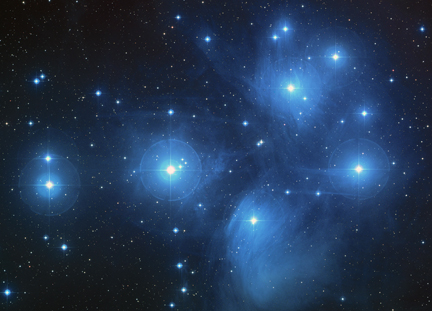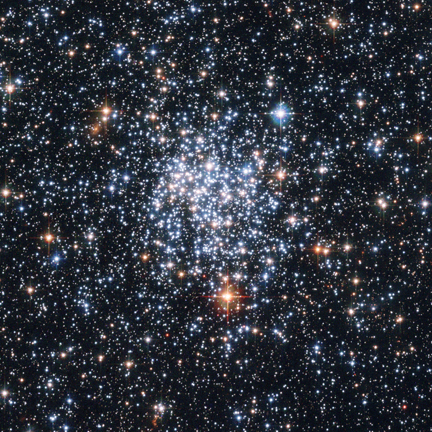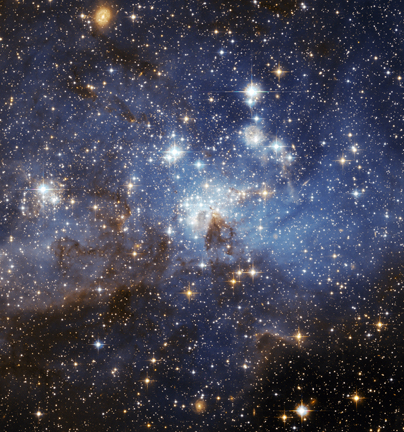Open Star Clusters
Overview
Open clusters are loose collections of stars that are bound together by their mutual gravity. They are sometimes referred to as galactic clusters because they lie within the disk of the galaxy.
Open clusters can contain anywhere from a few dozen to a few hundred stars. They have an familial heritage: They were all born out of the same parent nebula (or "stellar nursery"). Because a nebula generally has a single rate of movement through the galaxy, the stars that form from it will have that same relative velocity.
This similar relative velocity is what prevents open clusters together: If everything is moving in the same direction at the same speed, then there's no way for them to move apart.
However, since open cluster stars are only loosely bound together by gravity, it is fairly easy for stars that they pass by to disrupt them and to dissipate the cluster. Because of this, almost all open clusters are fairly young - generally no older than a few hundred million years. There are exceptions, though, such as the "King Cobra Cluster" (also known as M67) which has been dated to be about 3-5 billion years old.
In a very young open cluster, the stars will still have some material from their parent nebula in between them. This is because the intense radiation that young stars emit has not yet been able to destroy the interstellar dust and gas between them.
 |
| This is a 3-color composite of probably the most famous open cluster - The Pleiades (also known as M45). Nearly 1000 stars are members of the cluster, even though it has been named the "Seven Sisters" for over 2,000 years. It lies approximately 440 light-years away. The nebula that can be seen in the image is actually not related to the cluster, but the stars are just moving through it. This photograph was taken by the Palomar 48" telescope. |
Uses
Stellar Evolution: Please Note: This sub-section will likely not make sense if you have not read the page on the Hertzsprung-Russell Diagram.
In stellar evolution models, there are many different variables to consider, especially the mass of the star and the composition (how much hydrogen vs. helium vs. heavier elements), as well as the age.
Open clusters are useful in validating models of stellar evolution because one of the major variables - composition - is identical among all the stars, and the time-dependent variable of age is also identical. In this sense, an open cluster represents a "snap-shot" of up to hundreds of stars that are all identically aged and composed, but just having different masses.
In addition, any differences in brightness and color are a true reflection of the star brightness and color because they are all the same distance from Earth (astronomically speaking).
The Astronomical Distance Ladder: Determining distances in astronomy is very important to our understanding of the universe for many different reasons, not the least of which are that, without distance, we don't know how bright something actually is and so we can't know its mass, energy output, size, or other characteristics.
Open clusters form an important rung on the astronomical distance ladder (discussed in-depth under the "Foundations of Astronomy" section of this site on the page, "How to Measure Distances"). The distances to the closest clusters - out to about 500 light-years - can be calculated via the parallax method.
Once a few nearby open cluster distances are calculated, they can be used to determine the distances to other open clusters, out to a distance of about 30,000-40,000 light-years (10-15 kpc (kilo-parsec)). Once the distances to these is calculated, the distance to a special type of star known as a Cepheid Variable can be calculated if they are within the cluster.
Cepheid variable stars are the next step of the distance ladder, and they can be used to calculate distances out to about 50,000,000 light-years (15 Mpc). See either the page on Variable Stars or How to Measure Distances for more information on Cepheid variables.
Hubble Gallery of Open Clusters
 |
| This is a Hubble Space Telescope image of the open cluster NGC 602. It is a very young cluster, and the intense radiation from the young stars is rapidly blowing a cavity in the nebula that surrounds it. This cluster is approximately 200,000 light-years away in the Small Magellanic Cloud. Click here for the HubbleSite description and more images. |
 |
| This is a Hubble Space Telescope image of the open cluster NGC 265. It is an open cluster that lies in the Small Magellanic Cloud. Click here for the HubbleSite description and more images. |
| This is a Hubble Space Telescope image of the large star-forming region LH 95 in the Large Magellanic Cloud, about 160,000 light-years away. Click here for the HubbleSite description and more images. |
